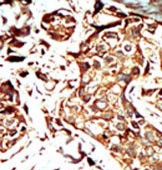BRD3 Antibody (C-term)
Purified Rabbit Polyclonal Antibody (Pab)
- SPECIFICATION
- CITATIONS: 1
- PROTOCOLS
- BACKGROUND

Application
| IHC-P, WB, E |
|---|---|
| Primary Accession | Q15059 |
| Reactivity | Human, Mouse |
| Host | Rabbit |
| Clonality | Polyclonal |
| Isotype | Rabbit IgG |
| Calculated MW | 79542 Da |
| Antigen Region | 672-702 aa |
| Gene ID | 8019 |
|---|---|
| Other Names | Bromodomain-containing protein 3, RING3-like protein, BRD3, KIAA0043, RING3L |
| Target/Specificity | This BRD3 antibody is generated from rabbits immunized with a KLH conjugated synthetic peptide between 672-702 amino acids from the C-terminal region of human BRD3. |
| Dilution | IHC-P~~1:50~100 WB~~1:1000 E~~Use at an assay dependent concentration. |
| Format | Purified polyclonal antibody supplied in PBS with 0.09% (W/V) sodium azide. This antibody is prepared by Saturated Ammonium Sulfate (SAS) precipitation followed by dialysis against PBS. |
| Storage | Maintain refrigerated at 2-8°C for up to 2 weeks. For long term storage store at -20°C in small aliquots to prevent freeze-thaw cycles. |
| Precautions | BRD3 Antibody (C-term) is for research use only and not for use in diagnostic or therapeutic procedures. |
| Name | BRD3 {ECO:0000303|PubMed:18406326, ECO:0000312|HGNC:HGNC:1104} |
|---|---|
| Function | Chromatin reader that recognizes and binds acetylated histones, thereby controlling gene expression and remodeling chromatin structures (PubMed:18406326, PubMed:22464331, PubMed:27105114, PubMed:32895492). Recruits transcription factors and coactivators to target gene sites, and activates RNA polymerase II machinery for transcriptional elongation (PubMed:29567837, PubMed:32895492). In vitro, binds acetylated lysine residues on the N-terminus of histone H2A, H2B, H3 and H4 (PubMed:18406326). Involved in endoderm differentiation via its association with long non-coding RNA (lncRNA) DIGIT: BRD3 undergoes liquid-liquid phase separation upon binding to lncRNA DIGIT, promoting binding to histone H3 acetylated at 'Lys-18' (H3K18ac) to induce endoderm gene expression (PubMed:32895492). Also binds non-histones acetylated proteins, such as GATA1 and GATA2: regulates transcription by promoting the binding of the transcription factor GATA1 to its targets (By similarity). |
| Cellular Location | Nucleus. Chromosome. Note=Detected on chromatin |
| Tissue Location | Ubiquitous.. |

Provided below are standard protocols that you may find useful for product applications.
Background
This gene was identified based on its homology to the gene encoding the RING3 protein, a serine/threonine kinase. The gene localizes to 9q34, a region which contains several major histocompatibility complex (MHC) genes. The function of the encoded protein is not known.
References
Kaneko, H., et al., J Investig Allergol Clin Immunol 12(2):86-90 (2002).
Thorpe, K.L., et al., Immunogenetics 44(5):391-396 (1996).
Thorpe, K.L., et al., Gene 200 (1-2), 177-183 (1997).
If you have used an Abcepta product and would like to share how it has performed, please click on the "Submit Review" button and provide the requested information. Our staff will examine and post your review and contact you if needed.
If you have any additional inquiries please email technical services at tech@abcepta.com.














 Foundational characteristics of cancer include proliferation, angiogenesis, migration, evasion of apoptosis, and cellular immortality. Find key markers for these cellular processes and antibodies to detect them.
Foundational characteristics of cancer include proliferation, angiogenesis, migration, evasion of apoptosis, and cellular immortality. Find key markers for these cellular processes and antibodies to detect them. The SUMOplot™ Analysis Program predicts and scores sumoylation sites in your protein. SUMOylation is a post-translational modification involved in various cellular processes, such as nuclear-cytosolic transport, transcriptional regulation, apoptosis, protein stability, response to stress, and progression through the cell cycle.
The SUMOplot™ Analysis Program predicts and scores sumoylation sites in your protein. SUMOylation is a post-translational modification involved in various cellular processes, such as nuclear-cytosolic transport, transcriptional regulation, apoptosis, protein stability, response to stress, and progression through the cell cycle. The Autophagy Receptor Motif Plotter predicts and scores autophagy receptor binding sites in your protein. Identifying proteins connected to this pathway is critical to understanding the role of autophagy in physiological as well as pathological processes such as development, differentiation, neurodegenerative diseases, stress, infection, and cancer.
The Autophagy Receptor Motif Plotter predicts and scores autophagy receptor binding sites in your protein. Identifying proteins connected to this pathway is critical to understanding the role of autophagy in physiological as well as pathological processes such as development, differentiation, neurodegenerative diseases, stress, infection, and cancer.


